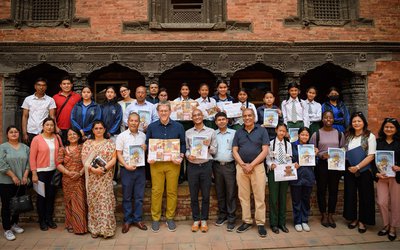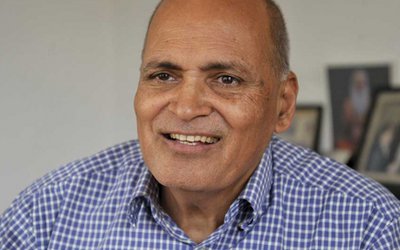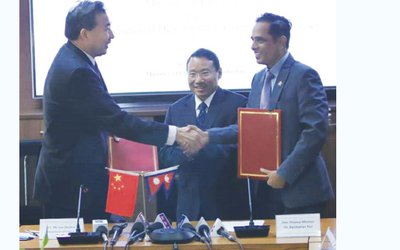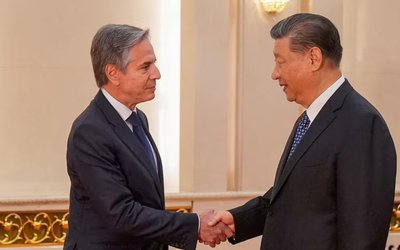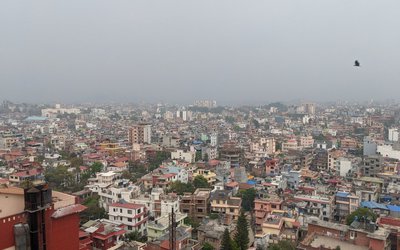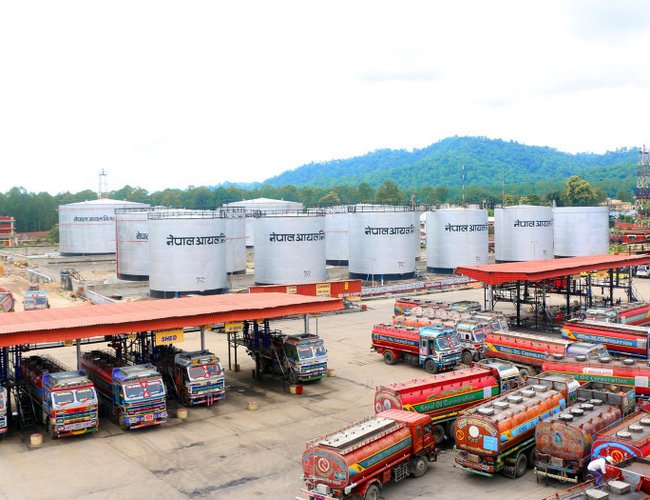
As with many areas of technology, the transport sector too is undergoing a revolution globally; and Nepal will also be (or is rather already) swept into its vortex. That transformation, however, ismore in its social aspects than in gadgetry innovations, although it is innovation in other domains (IT and communication as well as plummeting price of solar photovoltaics (PVs)) that is fueling how society views and uses mobility devices.
Transportation devices have always been associated with power, including military power to move armies and arms quickly. They have also been symbols of luxury that comes with the trappings of power – whether it was Nepal’s first car carried over Chitlang pass a century ago to Kathmandu for the Rana rulers to ride around the few kilometers of available road in the capital or the luxury SUVs ferrying Loktantra’s politicians and senior bureaucrats today (let’s not forget the Pajero SUV scandals of the late 1990s). Use of new transportation devices for the benefit of the larger economy only started with the Dhorsing-Matatirtha goods carrying ropeway built exactly a century ago, even though – given the nature of the Rana regime then – it was used to ferry construction material for Rana palaces and cheap Tarai rice for the labourers building them. Unfortunately, this mountain- and climate-friendly technology (it did not need massive bulldozing of fragile hill slopes and ran not on imported diesel but Nepali hydropower from its first such plant in Pharping at the southern end of Kathmandu Valley, consuming half as much energy as trucks to carry the same amount of goods) was quickly marginalized once the Tribhuvan highway was built ushering in the age of petroleum-fueled trucks and buses.
Currently Nepal’s fossil fuel addiction is severe: scholars at the Center for Renewable Energy at Pulchowk Institute of Engineering calculate that the country spends over 170% of its total goods export earnings to import petroleum products. And even in hydroelectricity that the country ostensibly has rich potential, because of planning failure over the last two decades of Loktantra that failed to build storage hydro projects, the country imports several times more of dirty coal-fired electricity from India than it exports monsoon surplus clean hydropower. Of the total fuel imported by Nepal, two-thirds are consumed by the transport sector. There are some 3.2 million registered vehicles in Nepal of which 1.2 million are in Kathmandu Valley alone; and 2.5 million (or 78%) are petrol-consuming motorcycles.
Not only is this fossil fuel addiction debilitating for the country’s economy, it has also brought about frightening security as well as pollution challenges. This petroleum dependence has allowed our southern neighbour to impose four economic blockadeson Nepal – crippling all transportation similar to Covid lockdowns of recent times – tobring about its political submission, including regime change. The first blockade was by Jawaharlal Nehru against King Mahendra between April to October 1962, which was lifted only with the Sino-Indian border war between 20thOctober to 21stNovember 1962. The second was by Indira Gandhi (also against King Mahendra) between 1stNovember 1970 to 26thAugust 1971. It was lifted only when Bangladesh liberation war intensified and Nepal blockade was having a bad impact on the morale of Indian Gorkha soldiers whose families back home were suffering. (Incidentally, as a background, Bangladesh was liberated in December 1971, King Mahendra passed away in January 1972, and India’s annexation of Sikkim began a year later and was to completed in May 1975.)
The third blockade was the longest between 23rdMarch 1989 to 1stJuly 1990 by Rajiv Gandhi against King Birendra and the Panchayat system, which collapsed in April 1990 with King Birendra declaring its abolition and the restoration of the multiparty system. The fourth blockade between 23rdSeptember 2015 till 5thFebruary 2016 was imposed by Narendra Modi against Nepal’s parliamentary parties for their promulgating a new constitution (three days earlier on 20th September) which did not incorporate Indian wishes of bifurcating Nepal into hill versus entire Tarai as one province. (“Ek Madhesh Ek Pradesh” was the slogan promoted by Delhi since the days of Indira Gandhi as recounted by its former RAW chief R.K. Yadav; and the 2015 constitution has also been criticized inside Nepal by many constitutional scholars and dissatisfied political parties for its technical and structural flaws but who do not subscribe to Delhi’s views). Because it was directed against not just a single monarch but against mass-based parties, the ill-will it created in Nepal against Delhi went viral, and sadly even became inter-generational.
Fossil fuel addiction has also brought about severe environmental pollution: IoE scholars calculate that 28% of pollution in Kathmandu Valley is from the transport sector. CO2 emissions from its ever-rising fleet of vehicles was 2.7 million tons in 2022 and is slated to reach 4.5 million tons in 2025 and 6.4 million tons in 2030 (in addition to over hundred thousand tons of CO, NOx, hydrocarbons and particulate matters). Add to this the poor quality of roads where vehicles kick up the same dust over and over again as well as household waste thrown on the streets, not collected in time by municipalities and pulverized to dust by plying vehicles, presence of smoke belching brick kilns etc. and one gets a toxic atmosphere in a valley where temperature inversion (when cool air is trapped below a warm upper layer) exacerbates the smog by not allowing it to be disbursed.
All this has to be reversed for both economic security and environmental health reasons. But how? Our main big political parties are beholden to the fossil fuel industry (vehicle importers, petrol pump owners and LPG traders, truck and bus operators, spare parts dealers etc.) for big money contributions that allow them to keep their party henchmen on their payroll and win elections (whichassures their remaining as defenders of the status quo). Nepal’s finance ministry in remaining revenue-addicted, is also addicted to fossil fuels because in the last financial year alone they received over a hundred billion rupees in revenue from petroleum import taxes. They are very loathe to part with that bonanza, hence their imposition of heavy taxes on import and sales of electric vehicles, the country’s macroeconomic wellbeing be hanged! Moreover, the social mood they have created is not the improvement of public transport or mass transit but ownership of private cars and motorcycles as the badge of social success.
The hope actually lies in what is happening both locally and globally, including with pressures to act on climate change concerns, and with those phenomena seeping into Nepal mostly via the private, civic and informal sectors. Vehicle owners who have switched to electric describe how their fuel cost has come down to a fifth of what they previously spent on petrol. One even said it came to zero for him because he had programmed his home’s smart solar invertor to dump its stored charge to his vehicle from midnight to 5AM, thus saving him from paying anything extra to the electric utility! This fuel economy has seen even some minivan operators on the Sindhuli highway operating electric ones. Economic efficiency is indeed a big driver of technological shift.
The bigger story comes from Europe, America and China with the shift away from “mobility as a product” (i.e., owning a vehicle) to “mobility as a service” (buying mobility from such service providers without the hassle of having to own and maintain a car). Energy expert Daniel Yergin, in his new book The New Map: Energy, Climate and the Clash of Nations describes how more and more people are opting not to own vehicles (and all the hassles that come with its license, upkeep, tax, garage space, regulations etc.) but to use services like Uber (and Pathao in Nepal!) to go where they need to without having to worry about driving, parking and other issues.
Departments of Transport in the UK estimate that in the 17-20 age group, having a driving license has fallen from 51% in 1990 to 29% in 2017 (and from 81% to 69% in the 21-29 age group). It is no longer the badge of “coming of age”! Places like Sweden in Europe have taken the “mobility as service” concept even further by merging mobile phones, global positioning, online payment systems, and a range of transport options from taxis and city provided electric bicycles to public mass transport buses and railways into one bundled purchase package either singly or for an entire season. In some cases, this also includes home delivery: instead of having to go out and buy goods the goods come to you, thus saving both time and energy.
What this means for Nepal is the challenge to bring in political actors at both national and municipal levels who are committed to economically efficient, climate- and national security-friendly multimodal public transport. They, with backing from social and environmental activists as well as renewable energy committed businesses, would need to bring in legislation that encourages higher passenger-mile options and discourages single occupancy vehicles as well as reforms the entire transport management agencies. There is hope, finally, that this will come about with the younger and better educated independent politicians that have emerged since the last elections.

Dipak Gyawali
Gyawali is Pragya (Academician) of the Nepal Academy of Science and Technology (NAST) and former minister of water resources.
- Maldevelopment And Technology: Ethos Harbingering Coming Apocalypse
- Apr 03, 2024
- World Social Forum: Rethinking and Redefining Development Itself
- Feb 21, 2024
- Remembering An Inspiring Karma Yogi
- Jan 09, 2024
- New World Disorder And The Case For Ideology
- Dec 13, 2023
- Loktantra’s Moral Turpitude
- Nov 06, 2023






